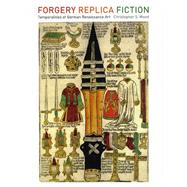
Forgery, Replica, Fiction
by Wood, Christopher S.-

This Item Qualifies for Free Shipping!*
*Excludes marketplace orders.
Rent Textbook
New Textbook
We're Sorry
Sold Out
Used Textbook
We're Sorry
Sold Out
eTextbook
We're Sorry
Not Available
How Marketplace Works:
- This item is offered by an independent seller and not shipped from our warehouse
- Item details like edition and cover design may differ from our description; see seller's comments before ordering.
- Sellers much confirm and ship within two business days; otherwise, the order will be cancelled and refunded.
- Marketplace purchases cannot be returned to eCampus.com. Contact the seller directly for inquiries; if no response within two days, contact customer service.
- Additional shipping costs apply to Marketplace purchases. Review shipping costs at checkout.
Summary
Author Biography
Table of Contents
| Acknowledgments | |
| Abbreviations | |
| Credulity | |
| Druid portraits | |
| How to relax the paradox | |
| Strange temporalities of the artifact | |
| Reference by Artifact | |
| Relics of earliest Europe | |
| Creative archeology | |
| Replica chains | |
| Reference by typology | |
| Resemblance as an emergent property | |
| Relics dependent on labels | |
| Onomastic magic | |
| Germany and “Renaissance” Destructive intimacy with the distant past | |
| No German “Middle Ages” | |
| Modernity as disenchantment | |
| A different way to describe modernization | |
| The German career of the heathen forms | |
| Disruption of the substitutional chain by print | |
| Forgery | |
| The fabrication of facts | |
| Document forgery as paradigm | |
| Retrospective tombs | |
| The translation of St. Simpertus | |
| Likeness without reference | |
| Some misidentified portraits | |
| The true image of the emperor | |
| The iterable profile | |
| The colossus of Crete - Mirabilium | |
| The quest for the bones of Siegfried | |
| Replica | |
| Recovery of the round arch | |
| The return of Romanesque, in two dimensions | |
| Alphabetic archeology | |
| Early experiments in epigraphic perfection | |
| Career of the Trajanic majuscule in Germany | |
| Publication of icons and relics | |
| Maximilian amplified | |
| Replication of irregular information | |
| Scholarly ambivalence about print | |
| Urban archeology | |
| Fiction | |
| Learned credulity | |
| Quasi-antiquities | |
| Fictional architecture | |
| Hypertrophy of alphabetic choice | |
| Ethnologies of form | |
| Convergences on the epigraphic ideal | |
| Unreadable alphabets | |
| Banishment, temporal and spatial, of the nude | |
| The tomb of the poet | |
| The tomb of the emperor | |
| “Colossal puppets” | |
| The tremor of forgery | |
| Fiction and counterfiction | |
| Re-enactment | |
| Virtual pilgrimage | |
| Devotion folded over on itself | |
| Paradoxes of the signature | |
| Pressures on the referential model | |
| Art and prophecy | |
| The future of credulity | |
| Figure Credits | |
| Index | |
| Table of Contents provided by Publisher. All Rights Reserved. |
An electronic version of this book is available through VitalSource.
This book is viewable on PC, Mac, iPhone, iPad, iPod Touch, and most smartphones.
By purchasing, you will be able to view this book online, as well as download it, for the chosen number of days.
Digital License
You are licensing a digital product for a set duration. Durations are set forth in the product description, with "Lifetime" typically meaning five (5) years of online access and permanent download to a supported device. All licenses are non-transferable.
More details can be found here.
A downloadable version of this book is available through the eCampus Reader or compatible Adobe readers.
Applications are available on iOS, Android, PC, Mac, and Windows Mobile platforms.
Please view the compatibility matrix prior to purchase.
